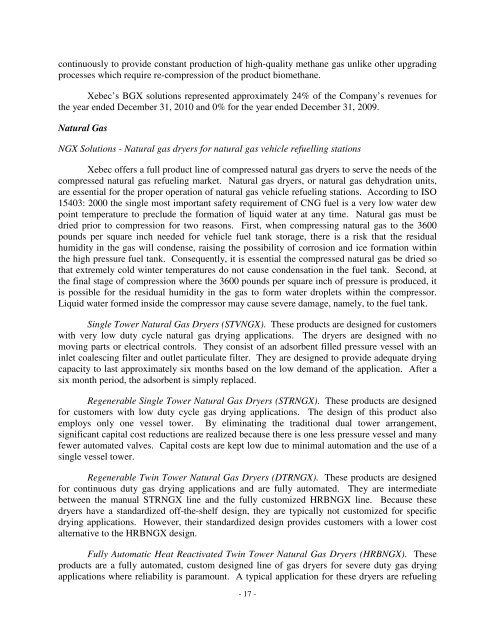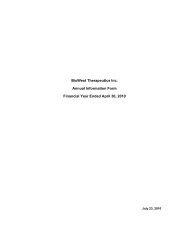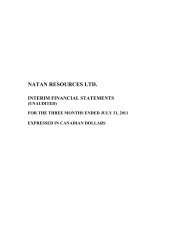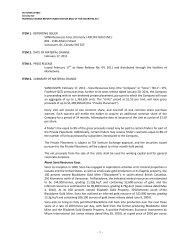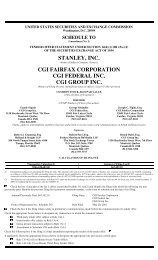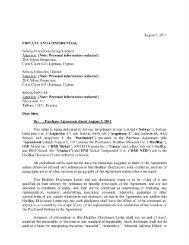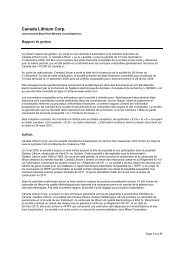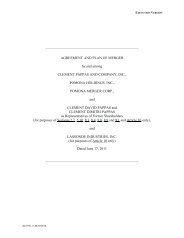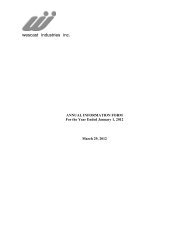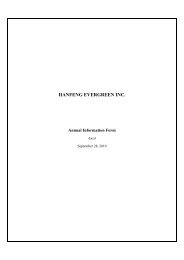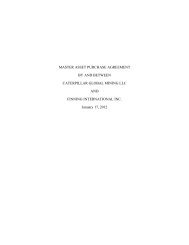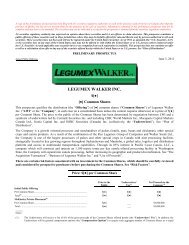ANNUAL INFORMATION FORM – XEBEC ADSORPTION INC. – For ...
ANNUAL INFORMATION FORM – XEBEC ADSORPTION INC. – For ...
ANNUAL INFORMATION FORM – XEBEC ADSORPTION INC. – For ...
Create successful ePaper yourself
Turn your PDF publications into a flip-book with our unique Google optimized e-Paper software.
continuously to provide constant production of high-quality methane gas unlike other upgrading<br />
processes which require re-compression of the product biomethane.<br />
Xebec’s BGX solutions represented approximately 24% of the Company’s revenues for<br />
the year ended December 31, 2010 and 0% for the year ended December 31, 2009.<br />
Natural Gas<br />
NGX Solutions - Natural gas dryers for natural gas vehicle refuelling stations<br />
Xebec offers a full product line of compressed natural gas dryers to serve the needs of the<br />
compressed natural gas refueling market. Natural gas dryers, or natural gas dehydration units,<br />
are essential for the proper operation of natural gas vehicle refueling stations. According to ISO<br />
15403: 2000 the single most important safety requirement of CNG fuel is a very low water dew<br />
point temperature to preclude the formation of liquid water at any time. Natural gas must be<br />
dried prior to compression for two reasons. First, when compressing natural gas to the 3600<br />
pounds per square inch needed for vehicle fuel tank storage, there is a risk that the residual<br />
humidity in the gas will condense, raising the possibility of corrosion and ice formation within<br />
the high pressure fuel tank. Consequently, it is essential the compressed natural gas be dried so<br />
that extremely cold winter temperatures do not cause condensation in the fuel tank. Second, at<br />
the final stage of compression where the 3600 pounds per square inch of pressure is produced, it<br />
is possible for the residual humidity in the gas to form water droplets within the compressor.<br />
Liquid water formed inside the compressor may cause severe damage, namely, to the fuel tank.<br />
Single Tower Natural Gas Dryers (STVNGX). These products are designed for customers<br />
with very low duty cycle natural gas drying applications. The dryers are designed with no<br />
moving parts or electrical controls. They consist of an adsorbent filled pressure vessel with an<br />
inlet coalescing filter and outlet particulate filter. They are designed to provide adequate drying<br />
capacity to last approximately six months based on the low demand of the application. After a<br />
six month period, the adsorbent is simply replaced.<br />
Regenerable Single Tower Natural Gas Dryers (STRNGX). These products are designed<br />
for customers with low duty cycle gas drying applications. The design of this product also<br />
employs only one vessel tower. By eliminating the traditional dual tower arrangement,<br />
significant capital cost reductions are realized because there is one less pressure vessel and many<br />
fewer automated valves. Capital costs are kept low due to minimal automation and the use of a<br />
single vessel tower.<br />
Regenerable Twin Tower Natural Gas Dryers (DTRNGX). These products are designed<br />
for continuous duty gas drying applications and are fully automated. They are intermediate<br />
between the manual STRNGX line and the fully customized HRBNGX line. Because these<br />
dryers have a standardized off-the-shelf design, they are typically not customized for specific<br />
drying applications. However, their standardized design provides customers with a lower cost<br />
alternative to the HRBNGX design.<br />
Fully Automatic Heat Reactivated Twin Tower Natural Gas Dryers (HRBNGX). These<br />
products are a fully automated, custom designed line of gas dryers for severe duty gas drying<br />
applications where reliability is paramount. A typical application for these dryers are refueling<br />
- 17 -


